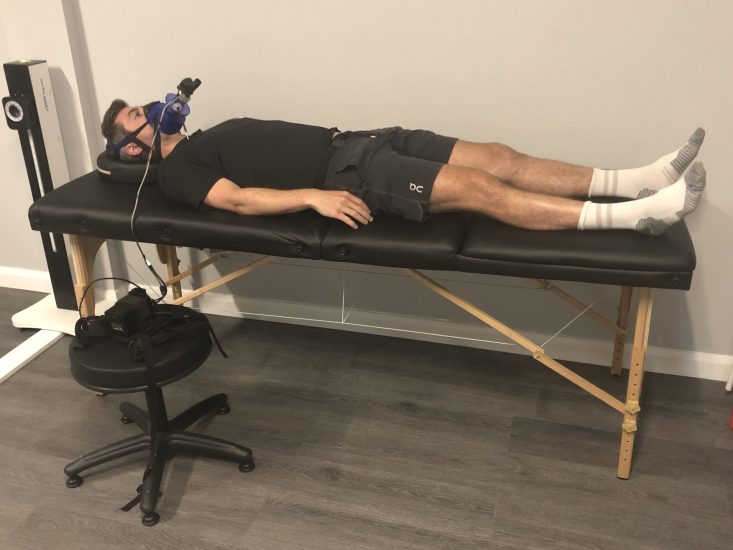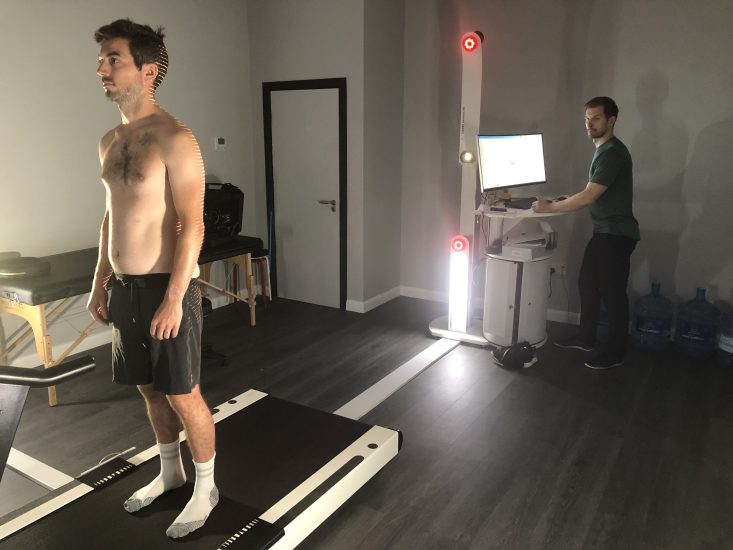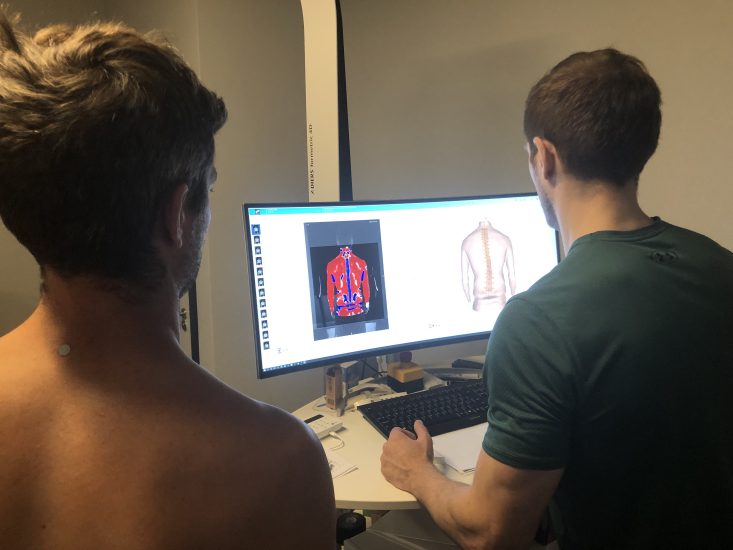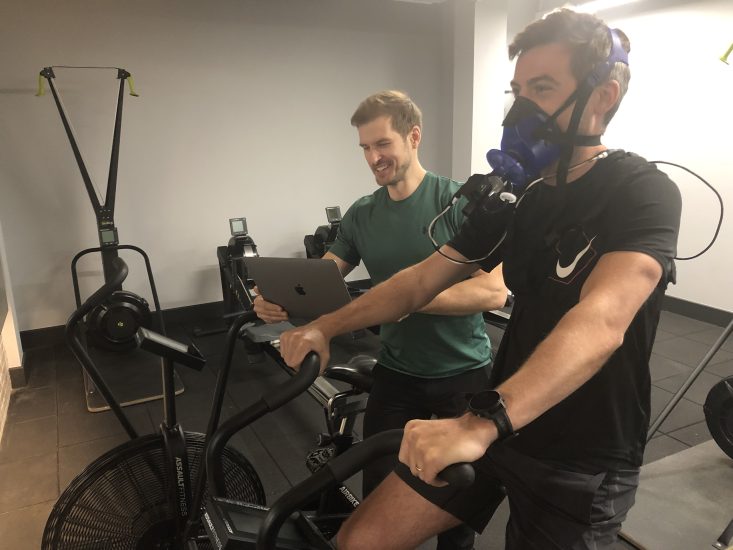Previously limited to elite athletes, metabolic testing can now help us all train smarter. MF writer Charlie Allenby travels to Precision Health in London to answer the question, what is metabolic testing?
I’m lying on a table in a subterranean room in London’s East End, a stone’s throw from the notorious Blind Beggar pub that was frequented by the Krays. I have a mask strapped to my face and I’ve been instructed to lie still for ten minutes before “the real fun begins”. While it might sound like I’ve got caught up in a spot of gangland retribution, my minders are actually qualified scientists and coaches from Precision Health. This is the latest state-of-the-art gym in the UK capital offering metabolic testing to its clients. But what exactly is metabolic testing?
Slow burner? Learn how to speed up your metabolism
The mask I’m wearing is part of a portable metabolic testing kit that would set you back £7,000. The examination I’m undertaking is just one of the advanced assessments that the space offers.
To my right is its motion lab, which 30 minutes before had revealed a minor postural imbalance I wasn’t previously aware of. The only motion analysis system of its kind in the UK, it uses a special treadmill and three cameras capable of taking 250 photos a second to create a 3D scan of your skeleton while standing, walking and running. Oh, and the system costs £148,000.
An InBody body composition machine and facilities to analyse key blood markers complete the gym’s four-pronged suite.
Related content:
- Weight Loss vs Fat Loss: What’s The Difference?
- How To Lose Belly Fat (Without Starving Yourself)
- Bodyweight HIIT home workout to burn fat, fast
Personal training plans
The testing is included in its membership, where the cheapest plan will set you back £212 a month. The thinking is that, by making lab-level data accessible to regular gym-goers (albeit ones with deep pockets), individuals can receive truly personalised, evidence-based training plans, and guaranteed results in the process.
“My personal strategy has always been test, don’t guess,” says Precision Health’s co-founder and director of science, Christian Thomson. A one-time kickboxing world champion, it’s clearly a method that has served him well. “We’re not taking away the intuition or knowledge of the coach,” he adds. “We’re just supplementing it with objective data.”
This approach to training can be extremely beneficial for average Joes. It also removes the process of trial and error that can cause some to abandon a training plan before it’s reached its conclusion.
“If we have this information,” says Thomson, “not only do we start getting results a lot faster, but our ability to tweak what we’re doing and improve those results is much greater.”
Discover the best low-calorie beers

Calculating resting metabolic rate (RMR) involves a heart rate monitor and muscle oxygenation sensor
What is metabolic testing?
Back to the treatment table and I’m a few minutes into the first stage of my metabolic test. In addition to the mask, I’ve been fitted with a Polar heart rate chest strap and a Moxy muscle oxygenation sensor has been taped to my thigh.
“A metabolic test measures the exchange of oxygen and carbon dioxide as you breathe,” explains Thomson. “Indirectly, it tells us how much energy is being used – how many calories are being burned and where those calories are coming from; what type of fuel is generally being used for that energy – for example, the ratio between fats and carbohydrates.”
There are two stages to a metabolic test: resting metabolic rate (RMR) and maximum volume of oxygen (VO2 Max). On their own, each shows how your body reacts to different intensities of stress. When combined, they provide a detailed picture of your readiness to embark on a training plan and any weaknesses you should work on.
Related content: Pros and cons of HIIT
“Exercise is a stress,” Thomson says. “Stress is good for us, but it also can be bad. [A metabolic test] looks at your capacity to respond to stress, which makes it good or bad – the defining point is whether your body is in a position to receive stress and have a positive or negative adaptation based on resources.”
If it reveals the latter, it might be that you actually need to dial back intensity or volume to get results.
“What you’ll see sometimes is less training will actually increase muscle mass and reduce fat mass more than more training,” says Thomson. “There’s a really complex system to do with stress adaptation that causes that.
“It gives us great power to periodise training efficiently for people as well. Without the understanding of where your stress level is, how can we start you in the right space to get progressive overload right? How do we stop you from reaching that peak too soon and, therefore, plateauing and exhausting your resources? You can’t know that without looking.”
Try these meal delivery services for healthy nutrition, fast

Precision Health’s motion analysis system – the only one of its kind in the UK – takes a 3D scan of Charlie’s skeleton
Understanding what your metabolic rate is
Your metabolism is the sum of all the chemical reactions in your body. It energises 37 trillion cells, powers all your vital organs and ensures your immune system functions to keep you alive. “On the most basic level,” explains metabolism specialist Dr Michael Mosley, “it is the process by which your body turns what you eat and drink into energy.
“You need that energy to move, digest food, keep warm, breathe and even think. The whole process is known as your basal metabolic rate.”
How that metabolic rate works, and how much energy it uses itself, is determined by a number of factors, including your size, build, gender and age. Body composition changes, activity levels and diet can also have an influence.
Historically, this sort of testing has been the preserve of elite athletes due to the costs. But it’s also focused on forms of exercise that are easy to simulate in a lab-based setting – such as running or cycling.
“It’s generally been used by endurance athletes,” Thomson adds, “because it’s the most obvious and easy way to measure things. When you’ve got something as simple as running in a straight line, there are not many variables going on there compared to playing football, for example, so it’s easier to say, ‘This effect has come from that.’”
Rev up your metabolism with this fat-burning workout
Calculating calories at rest
The portability of the PNOE system Precision Health uses, though, increases the functionality of the VO2 Max part of the test. Plus, it can be conducted on a variety of apparatus or equipment depending on your training focus. This is ideal if you’re not an out-and-out endurance athlete.
The process I’m currently undertaking is to find my resting state. The results from the breathing apparatus are cross-referenced against my heart rate and my muscles’ level of oxygenation. This paints a picture of my baseline.
“We can see how many calories you’re burning at rest, which gives us a really good indicator of what your calorie requirements are,” says Thomson. “All these things together allow us to properly plan nutritional and lifestyle mechanisms to improve your overall metabolic state.”
Knowing how many calories you actually need at rest, rather than guesstimating based on age, gender, height and weight, is key when training if you’re aiming for a calorie deficit or surplus. But the test reveals much more than that.
Need exercise nutrition tips? Here are 55 ways to eat better
My own results show that carbohydrates are the dominant energy source at rest. This could be a sign that my sympathetic nervous system (the part of the autonomic nervous system in control of the fight or flight response) is causing an imbalance.
In a matter of seconds, Thomson recommends that I up my meal intake from three to four a day. I’m also advised to increase the root vegetables and greens in my diet. “There’s too much baseline stress, so we want to reduce or balance that,” he says.
“By increasing the parasympathetic [nervous system], you will help balance the stress response. Eating itself is a parasympathetic activity. By eating more regularly, you’re boosting the parasympathetic network.
“On top of that, one of the jobs of the sympathetic nervous system is to release glucose into the blood. By eating slow-release carbohydrates like root vegetables and green leafy vegetables more regularly, there will be a constant release of glucose into the blood at a rate that is healthy for the body to maintain.
“That will reduce the need for the sympathetic nervous system to ramp up at any point in between meals.”

Charlie sees the results of his 3D skeleton scan, which reveals a minor postural imbalance
Find your aerobic capacity
Resting rate completed, it’s now time for the part of the examination I’ve been dreading. The idea of a VO2 Max test is to push your body to its complete limit to find your aerobic capacity. This is the maximum amount of oxygen your body can use to generate energy.
After this point, the energy system switches from aerobic to anaerobic, where glucose stores are broken down without oxygen. A side effect is an increase in lactate in the blood. When this can’t be cleared or used quickly enough, you come grinding to a halt.
Thomson explains that, by knowing your heart rate when those dominant energy sources change, you’re able to increase the accuracy of training intensities. This is particularly true in endurance-focused sports where sessions are often broken down into drills targeting specific effort zones such as ‘threshold’ (the top end of your aerobic energy system) or ‘anaerobic’.
He adds that it can also reveal shortfalls and areas you need to work on. Particularly if you switch to an anaerobic energy system quite early in the test. “If we see your early zones are squashed down or you’re going into that carbohydrate dominance really early in your heart rate cycle, your body is in a state where it’s ramping up the stress so fast that your ability to tolerate high volumes of intense exercise is probably going to be reduced.
“You’re going to burn through resources faster, creating this problem of overtraining faster as well.”

VO2 Max testing is the second stage of metabolic testing. This is where you push your body to the ‘max’ to find your aerobic capacity
VO2 Max testing
The test at Precision Health takes place on an air bike and is broken into three phases. The first is three minutes at an easy intensity (90 watts). After this, a nine-minute ramp test commences. Here, intensity increases (in this case by 20 watts) every minute, finishing at a heart-pumping 270 watts.
Finally, there are two minutes of complete rest that determine your ability to recover.
The 14 minutes fly by in a blur. As someone who trains predominately for long-distance cardiovascular events and is in the middle of an Olympic-distance triathlon training plan, I hoped I’d fair OK. But, I’m pleasantly surprised. Even during the final effort, I feel comfortable and like I have more in the tank. It seems like this VO2 Max test’s bark is worse than its bite.
Thomson confirms that the intensity increases should have been bumped up from 20 to 30 watts so that I had a chance of hitting my ceiling. But even so, the results show that my aerobic health is performing as it should, and I’m not at risk of overtraining.
Is it worth getting a metabolic test?
As someone who already analyses workout data such as heart rate, heart rate variability, and functional threshold power to track progress, a metabolic test provides fascinating insights that were previously the preserve of professional athletes.
Personally, it has revealed ways to supplement my training that a Strava activity or Garmin watch will never be able to. Plus, its ability to show weaknesses and reduce the risk of overtraining could be the difference between achieving your goals and chronic burnout.







